Early one morning, Norman and I dropped off our car for servicing at a local garage. We had breakfast at the Goat Café and then took a walk for an hour or so until it was time to retrieve the car. We were in a part of Toronto we don’t often visit, and were pleased to note two massive plane trees on our stroll. When we later mentioned them to our neighbour, artist Jane Hunter, she said, “Just like in Paris!”
Exactly. The Paris plane tree we know best grows just outside the apartment we have rented several times. We have seen it in all seasons with its maplelike leaves, its patchy multicoloured bark, and its bobbly seed pods. It grows out of the pavement, surrounded by those lacy iron rings common to Paris street trees.
Here it is, on May 1, 2019, just before the May Day parade, which accounts for the lack of traffic in the intersection and the heavy police presence. If trees are silent witnesses to history, our plane tree saw a bit of history that day, when the parade and the gilets jaunes were particularly lively.
We hope it has survived. More than 10 years ago, blogger Susan Walter of “Days on the Claise” documented the incursions of a fungus that has killed many plane trees across Europe. She wrote:
The deadly fungal disease was introduced accidentally in 1944 when American troops disembarked in Provence. The wooden munitions boxes made from American Sycamore P. occidentalis that landed with the troops were infected, and the local French plane trees were unable to resist this invader.
The thousands of plane trees lining the Canal du Midi, planted on Napoleon’s orders, were particularly affected and many had to be cut down. The good news is that scientists have bred a disease-resistant version to replace the lost trees. But replacing a 200-year-old tree with a new one is still a loss.
Disease is not the only threat. In 2022, an arborist called Thomas Brail hoisted himself into a plane tree on the Champ de Mars that was due to be cut down under a plan to expand tourist infrastructure around the Eiffel Tower in anticipation of the 2024 Paris Olympics. Forty trees in the area were eventually granted a reprieve, but individuals and environmental groups still need to be vigilant to alert the public when development clashes with the city’s green canopy.
Officially, the city has promised to plant 170,000 new trees by 2026 to reduce the urban heat island effect (that is, the heat that builds up in paved areas without green space – think the Avenue de l’Opéra in July). Between November 2020 and April 2023, the city planted 63,700 trees. Some are new; some replace dead or dying trees. That means 107,000 more to go in the next three years.

Plane trees are particularly favoured, as they tolerate air pollution, last for centuries, and send down deep roots. How deep? Here is an illustration from a City of Paris publication, showing the roots penetrating well below the level of the Métro and into the old quarries underneath the city.
It’s not just plane trees, of course. All kinds of species flourish in Paris, some of them in courtyards and private gardens, others along tree-lined streets and in parks. Recently, my niece Alex sent us a map called “Great Trees of Paris,” which showcases some of the city’s finest and most historic trees. The first one listed is the oldest living tree in Paris, the Robinia pseudoacacia in Square René Viviani in the 5th arrondissement. The name commemorates the man who planted it, Jean Robin, the king’s gardener, and the fact that it looks so much like an acacia that only a trained botanist can tell the difference. Robin had brought the seeds back from North America, so it is not a tree native to Europe.
This tree also features as part of a walking tour of trees on six sites created by the City of Paris, which also offers an interactive map of remarkable trees.
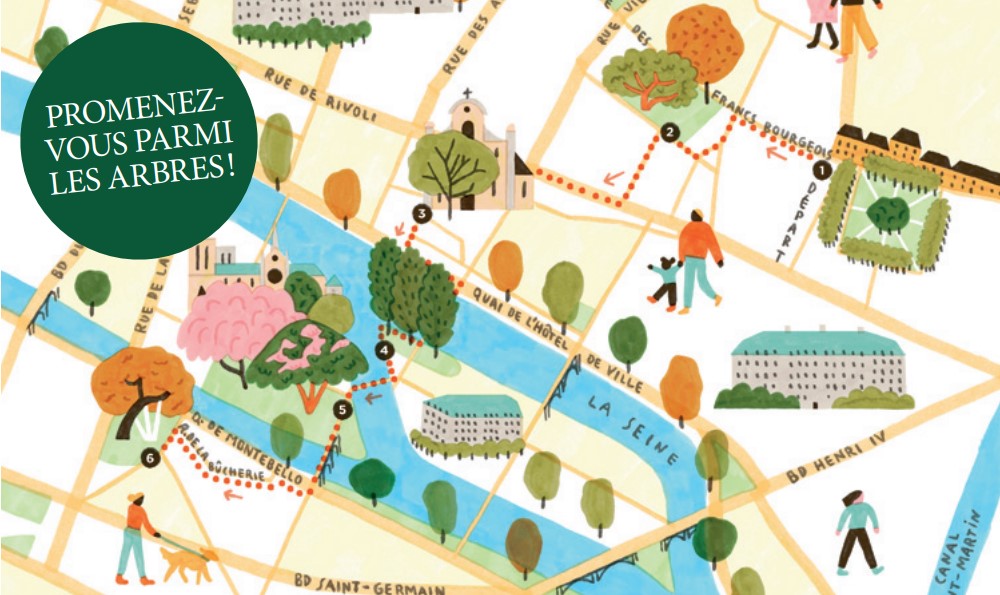
The walk starts with the horse chestnuts of the Place de Vosges that provide deep shade in summer…

…and leads pas the lilacs of the rue des Rosiers, the elm of the place St-Gervais – formerly the site of an enormous tree that served as a local meeting place for settling debts (the current tree is a descendant of the original and dates from 1935) – the poplars of the Ile St-Louis, the tamarisks and mimosas behind Notre Dame, and ending with the Robinia in the Square René Viviani.
The map Alex gave us contains 50 examples across the city, such as the four foxglove trees (Pawlownia tomentosa) in the rue Furstemberg. Foxglove trees are covered with lavender-coloured blossoms in spring. According to the information on the map, these four particular trees are protected with cosy little blankets in winter. (Update: the largest of the four was recently felled by the city, which claimed it was diseased and a security hazard.)

There is even a dawn redwood (Metasequoia glyptostroboides) in the Square de la Villa Sainte Croix in the 17th. This tree is familiar to us, as several of them grow in a nearby park in Toronto. It’s an odd-looking thing, with branches that emerge at sharp angles from the folds of the trunk (look at the tree behind the playground equipment on the right).

There are fig trees and hornbeams and ginkgos galore. A Judas tree in the Tuileries (shown below). Weeping willows trailing their leaves in the Seine. Persimmons and sweet gum in the Bois de Vincennes and a handkerchief tree in the Bois de Boulogne. Tulip trees in the Cité universitaire and a Kentucky coffeetree in Square Robert Schumann in the 16th (both of the latter are also trees that grow on our street in Toronto).

Adolphe Alphand’s massive Les Promenades de Paris contains detailed instructions on how to plant good-sized trees along avenues and in parks. Alphand was not satisfied with planting tiny little trees tied to a metal rod in the hopes that they would survive and grow up. He planted large trees with large root balls that were wheeled to their destinations using special equipment.
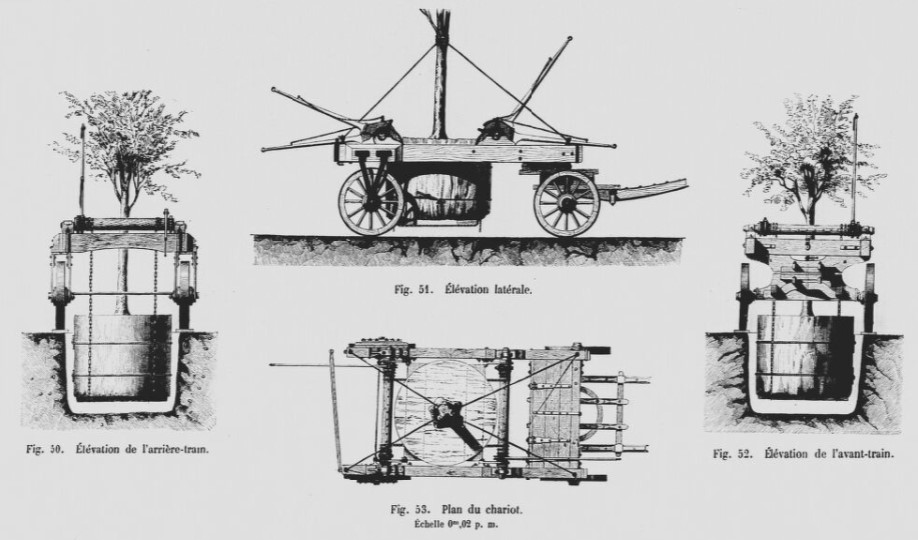
Once in place, Paris trees are not permitted to grow just anyhow. New trees may have a “corset” to keep them straight. These were in the Place Dauphine a few years ago.

Many are pruned to within an inch of their lives, maintaining rectangular canopies that remain within fixed limits. The trees on the Champs-Elysees are subjected to this treatment. It takes serious machinery to keep them in line.
Fruit trees may be espaliered, that is, flattened out or rendered two-dimensional. These ones are in the Jardin du Luxembourg.
Then there is pollarding, a very French fashion, whereby branches are cut back severely so that they become stubs from which new growth bursts out. Pollarding is done at regular intervals (about every five years) to keep the tree at a certain height. These ones were photographed in winter in the garden of the Observatoire.

And when trees get droopy, they are propped up with wooden beams or, in the case of the tree in the courtyard of the Musée des Arts et Métiers, held with a metal ring that is attached to the side of a building.
This elderly tree (a reader suggests it is a quince) in the garden of the Musée de Montmartre has a support shaped like a lyre.
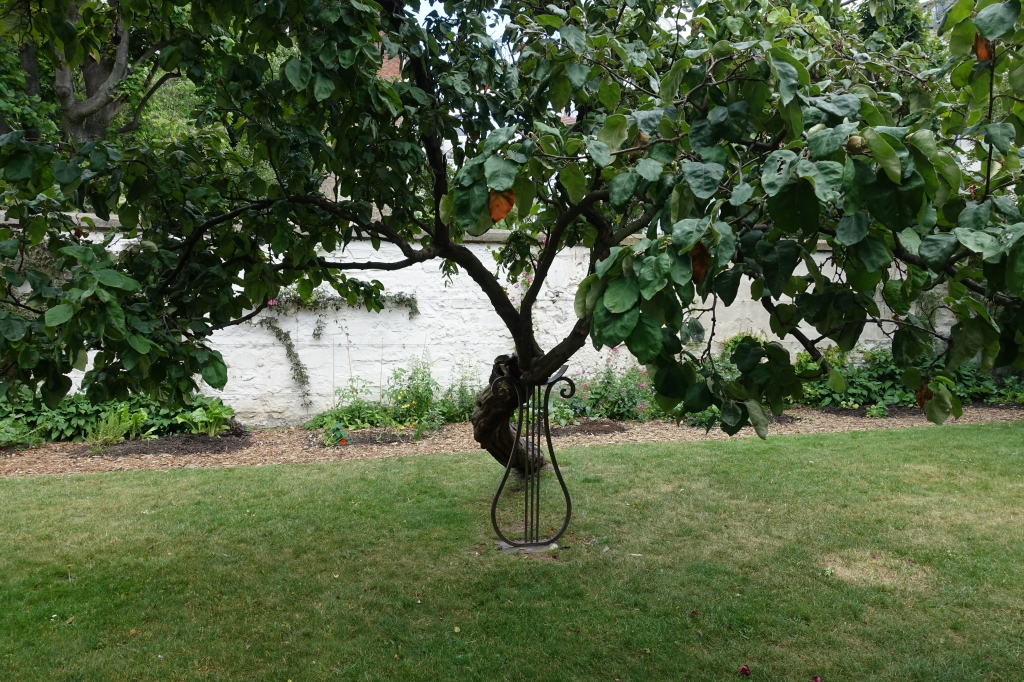
When you see older trees treated with such respect, the proposal to cut trees down around the Eiffel Tower seems all the more shocking.
I wonder where those additional 107,000 trees will fit into the city. Given the new law in France that commercial buildings must have green roofs (or solar panels), some may sprout from the rooftops. Between now and 2026, Paris will get greener and shadier.
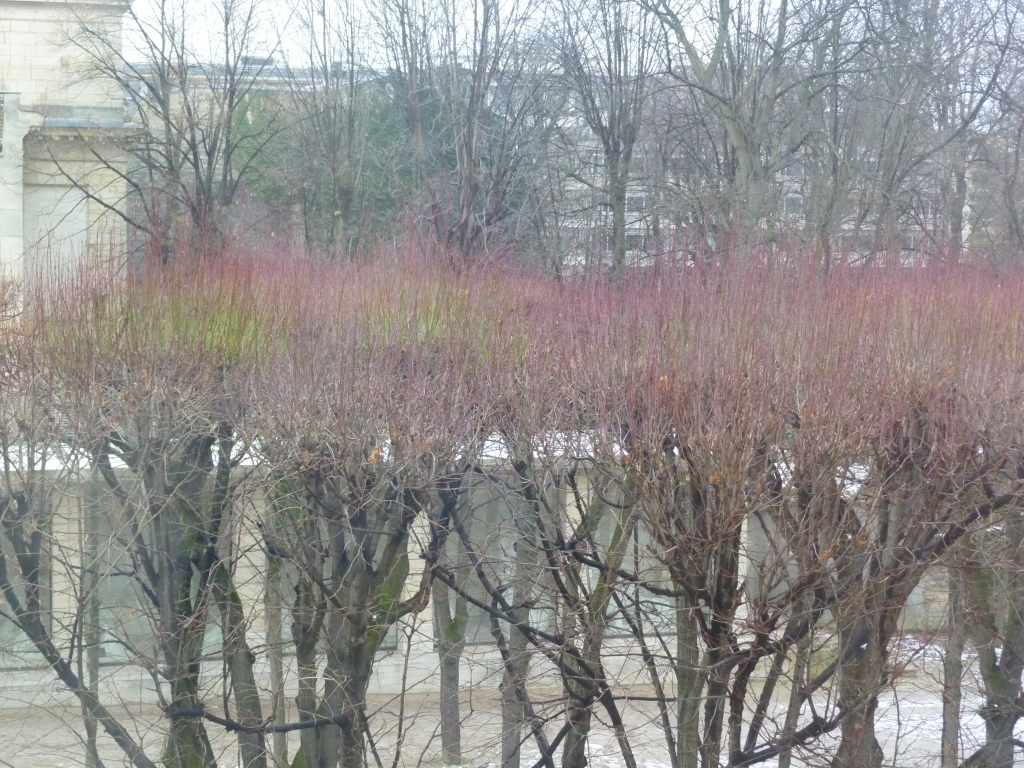
Text by Philippa Campsie; photographs of Robinia, Judas tree, foxglove tree and dawn redwood from Wikimedia Commons; photograph of Arts and Métiers by Norman Ball; all other photographs by author.
















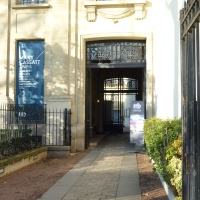
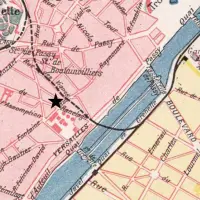









An unusual and worthy subject! As always, I learn so much from each of your posts. Must look for that charming lyre support in the garden of the Musee de Montmartre. As lovely as the plane trees and chestnuts of Paris are, I have often wished the city would plant more maples, so that we would see a more striking change to orange and red leaves in the autumn. Perhaps they have tried, but have found them not as hardy as the amazing plane trees with their deep roots?
According to the notes on the map, there is a silver maple in the Jardin du Luxembourg that puts on a nice display of colour in the fall.
Thanks for the link! Since I wrote that post the fungus does not seem to have spread too far north, so not much has changed as far as I know. I certainly haven’t noticed any major deaths in the Loire Valley, anyway.
I think the tree supported by the lyre might be a quince, btw.
A quince. Very likely. Thank you.
Howdy y’all!
Paris being my favorite city, I’ve been there often. It’s trees are one of its defining features. There is nothing better than wandering the streets enjoying the architecture and trees, coffee, wine, and pastries.
I’ve seen most of the trees you featured, especially the pear tree in Montmartre, or at least been to those sites.
Huzzah!
Jack
When you next go there, you will see even more trees than before!
I hope so. I’m glad to know that they are cooling the city with trees and promoting even more greens spaces.
what a great tree-story info this was. Being the daughter of a carpenter/former roofer, I knew (once) all the trees, their wood, their specialties, illnesses and their special gifts to humankind. But my dad is no more for a very long time and I ‘only’ enjoy the vista of trees on my walks, trips, travels. I was not often impressed by the trees in Paris, but have super fond memories of my times in Canada and England. Here in Switzerland we have many parcs and gardens with spectacular trees. We have plenty of botanical gardens, lots of mature and wonderful trees near water and spindly, amazingly deserty-kept ones in gorges and standing in rocks and cobbles where you can’t begin to understand how on earth they can stay and grow….Nature will win in the end, I’m sure.
Our garden at home is tiny, but we have room for a maple, a linden, an ash, a Japanese maple, an ornamental pear, and a dogwood. It is blessedly shady at this time of year.
how lovely. We now rent a groundfloor flat which I chose because from our patio we look at two old linden trees…. nature is always best!
Trees are our treasures. Long after we’ve gone they’ll be providing shade and clean air and fruit for generations to come.
I couldn’t agree more.
Pollarding! At last an explanation about the disfigurement of the trees in France. I’ve been intrigued by them for years and no-one has had an answer for me….obviously been asking the wrong people. Thankyou.
Here is some more information: https://www.pumpjackpiddlewick.com/what-is-pollarding/
Thankyou for your link to what looks like another interesting blog.
Thank you for such an interesting article. It is a barbaric notion to cut down the trees near the Eiffel Tower simply because they do not fit into the city’s planning for the Olympics. These trees should have the designation of vénérable treasures of the city and be protected as such. Whenever we go to Paris we pay a visit to our old friend Robinia pseudoacacia to appreciate its beauty and its longevity. Its like saying hello to a very old friend.
Since I posted the blog, a Paris friend has informed me that one of the trees in the place Furstemberg has been cut down by the city. I hope they replace it.
The tree supports are impressive. I can’t say I like pollarding much though.
This summer, the city of Paris seized the opportunity of the long French summer holidays to do a lot of infrastructure work ahead of next year’s Olympics.
The street outside my apartment in the 18th arrondissement is joining the 180 school streets in the city. The tarmac and pavement have been removed, new water and electric mains have been laid. The area will be fully pedestrianised, with gates at each end for emergency vehicles, with deep borders on both sides of the street, fully planted up with shrubs and including a dozen new trees. 126 new school streets have been added since the summer 2020.
The through traffic has already gone, and I cannot wait for the chance to sit out in the sun on a Sunday morning with a paper and a coffee. It may take a few years before I can enjoy the shade from the trees though.
Your mentioning of the Foxglove trees or as I prefer Pavlovnia (refering to a Russian ballerina) and I would like to tell you that on Av. de Laumière on its way up to Buttes Chaumont the whole avenue is lined by the Pavlovnia and I happened to experience them one early spring day before the leaves appear and it was a canopy of the lilac blossoms, most impressive. I always enjoy your work and I LOVE Paris in all of its variations from arrondisment to arrondisement. Blessings, Kenneth